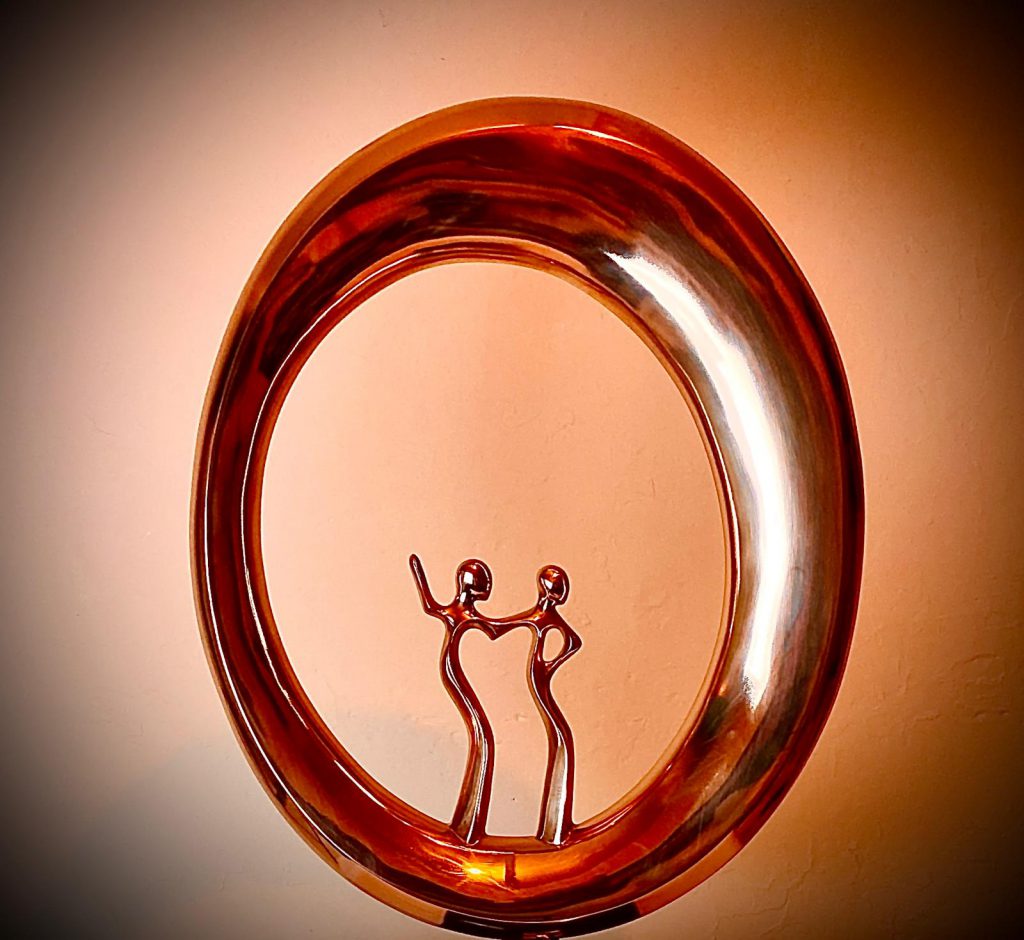“Friends into Eternity” by Ted Stourton: A Masterpiece of Modern Symbolism By John Mappin, Fine Art Collector.
In the storied timeline of human creativity—from the serene balance of Phidias’ marbles to the psychological charge of Rodin’s bronzes—there occasionally emerges a piece so timeless, so deceptively simple, and so profound in its message that it demands to be seen, studied, and ultimately remembered. “Friends into Eternity,” the latest sculptural creation by British artist Ted Stourton, is such a work.
Cast in polished bronze and mounted on a modest pedestal, the sculpture features two abstracted figures—graceful, upward-reaching, and unmistakably connected—enclosed within a continuous ellipse. The form evokes unity and infinity ; the figures, while minimal, pulse with expression. Stourton, known for his luminous canvases and metaphysical sensitivity, here distils the very idea of human connection into a sacred shape: the circle eternal.
Unlike a perfect circle, the ellipse contains both balance and movement. It breathes. It expands and contracts. This is no accident. The ellipse in Stourton’s work is not merely aesthetic—it is symbolic. It echoes the orbital motions of celestial bodies, the cycles of life and rebirth, and the liminal spaces between matter and meaning. It evokes the sacred geometry revered by Da Vinci and the early mystics, yet places it firmly in the now.
Within this sacred oval reside two figures—not quite male, not quite female, not bound by gender or time. Their abstraction is their power: they are all of us. They could be two friends, two souls, two lovers, or even two aspects of the same being. They dance, they reach, they remain—locked in an eternal communion.
To understand the gravitas of “Friends into Eternity,” one must situate it in the broader canon of sculptural expression. Like Brâncuși’s “The Kiss” or Hepworth’s “Oval Form,” Stourton’s piece achieves much with little. It does not shout; it hums. It stands with the eternal silence of Egypt’s Ka statues and the enduring embrace of Michelangelo’s “Pietà.”
But it also speaks to the present—to a fractured world yearning for permanence, intimacy, and truth. In its abstraction, it is universal. In its materiality—bronze, a metal used by warriors, kings, and poets—it is eternal.
Placed against the backdrop of classical architecture, as it is in the accompanying image, “Friends into Eternity” achieves an alchemical fusion of ancient wisdom and modern insight. It is, quite literally, a relic of the future—a piece we will carry with us into what comes next. It reminds us that in a world obsessed with speed and division, the eternal stillness of friendship, of unity, of soul connection, remains our highest aspiration.
This is not merely a sculpture. It is a talisman. A modern votive. A piece that would be as at home in the Uffizi or the Louvre as it would be in a private contemplative garden or the atrium of an interstellar vessel.
Ted Stourton has long defied categorisation. His works—whether in pigment or bronze—exist beyond trend or time. He is, perhaps, the last of the great metaphysical artists. And in “Friends into Eternity,” he may have achieved his most distilled and enduring statement.
Let the art world take note: this is not an ornament, but a proclamation.
Ted Stourton’s “Friends into Eternity” will stand with the works of Moore, Giacometti, and the ancients.
And like the friendship it immortalises, it will not fade.

